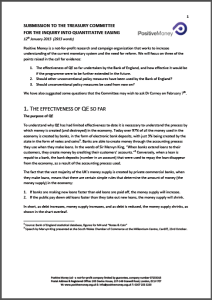Submission to Treasury Committee on QE


Ben Dyson has made a Submission to the Treasury Commission on their call for further evidence on the effectiveness of Quantitative Easing and how it could be made more effective.
He has addressed three points:
The effectiveness of QE so far undertaken by the Bank of England, and how effective it would be if the programme were to be further extended in the future.
Should other unconventional policy measures have been used by the Bank of England?
Should unconventional policy measures be used from now on?
Here are some extracts from the submission:
“…whilst QE was seen in the press as being the start of reckless creation of money by the state, in reality it was simply a case of the state taking over the (often reckless) creation of money that is normally undertaken by private commercial banks through their lending.”
“There was a critical flaw in the implementation of QE. The money created via QE was intended to replace the money that was disappearing from the real (non-financial) economy, as individuals and businesses paid down their existing debts. But instead of re-creating the money and injecting it into this part of the economy, the Bank of England injected the money into the financial part of the economy.”
“…by using newly created money to buy financial assets (bonds), QE has pumped new money into the financial markets, where it has stayed circulating and inflating prices of financial assets (stocks, bonds etc.). But it was not realistic to think that this newly created money would ever reach the real economy or have an effect on employment, economic growth or inflation. The lack of any significant
improvement in economic growth, despite the creation of such huge sums of money, shows that the money created has not reached the real economy.”
“If the money that was created via QE had been injected into the real economy instead of the financial sector, then we would have been likely to see immediate economic growth. As an example, a total of £375 billion has been created as a result of QE. If, over the same period of time, this money had been spent directly into the real economy (which counts towards GDP and growth figures) rather than being spent into the financial markets, then GDP would have been boosted by up to 6% a year above the level that it has been at.”
“It is worth stating the scale of the wasted opportunity of QE. Over the last 5 years we have had unemployment levels of over 2.5 million i.e. 2.5 million people looking for a useful way to spend their time. We have also had numerous cuts to infrastructure and construction projects (such as the schools rebuilding programme) because of a ‘lack of money’. The £375bn created by the Bank of England was sufficient to employ 2.5 million people full time on the national average salary for approximately 5 years.”